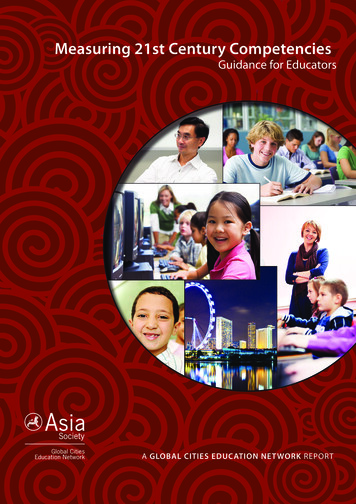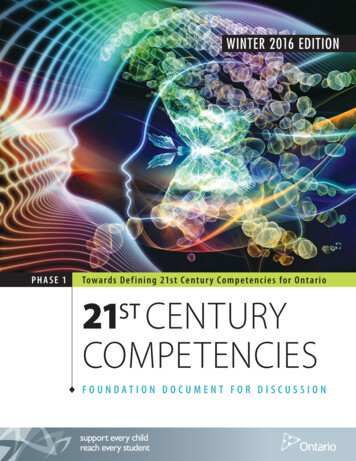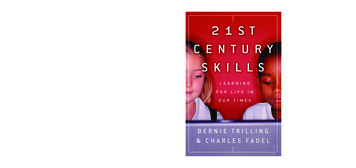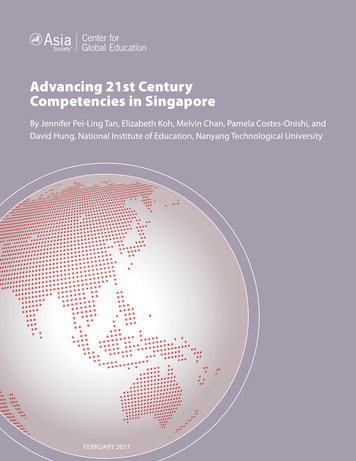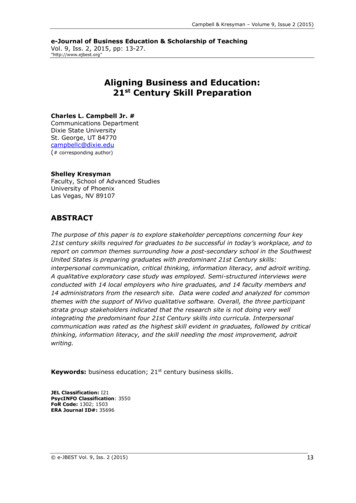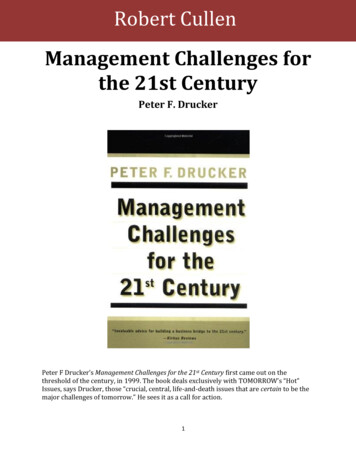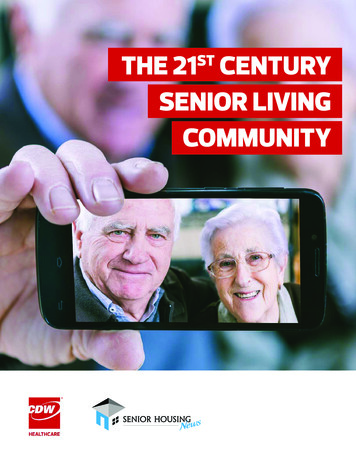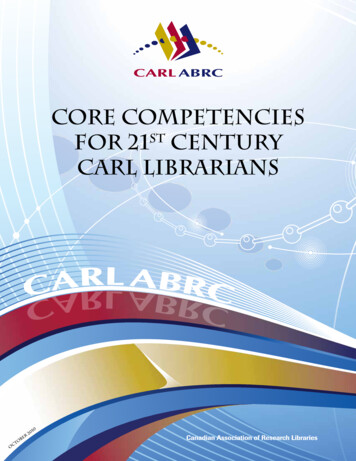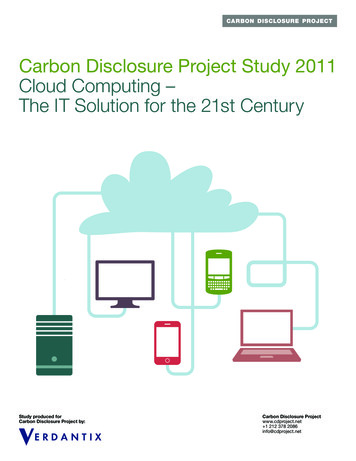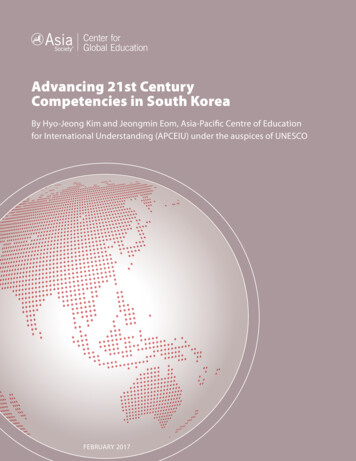
Transcription
Advancing 21st CenturyCompetencies in South KoreaBy Hyo-Jeong Kim and Jeongmin Eom, Asia-Pacific Centre of Educationfor International Understanding (APCEIU) under the auspices of UNESCOFebruary 2017
Advancing 21st Century Competenciesin South KoreaFebruary 2017Case Study Authors:Hyo-Jeong Kim and Jeongmin Eom, Asia-Pacific Centre of Education for International Understanding (APCEIU)under the auspices of UNESCO
Asia SocietyAsia Society is the leading educational organization dedicated to promoting mutual understanding andstrengthening partnerships among peoples, leaders, and institutions of Asia and the United States in a globalcontext. Founded in 1956 by John D. Rockefeller 3rd, Asia Society today is a global institution—withoffices throughout the United States and Asia—that fulfills its educational mandate through a wide rangeof cross-disciplinary programming. Across the fields of arts, business, culture, education, and policy, theSociety provides insight, generates ideas, and promotes collaboration to address present challenges and createa shared future.The Center for Global Education at Asia Society brings together leaders and institutions from aroundthe world to tackle one of the most critical education challenges today: how to educate all students foremployability and citizenship in a global era. Our mission is to develop global competence in students,young leaders, and educators as the foundation for understanding between people in the Asia Pacific regionand throughout the world. We accomplish this by working with educators, school districts, parents, andcommunities to ensure that they have the tools and support they need to globalize learning and prepareyoung people for our global future.AcknowledgmentsThis paper is one of five case studies that accompany the Asia Society report entitled “Advancing 21st CenturyCompetencies in East Asian Education Systems” by Professor Kai-ming Cheng from the University of HongKong. Professor Cheng assembled and led an international team of researchers who developed the case studyreports on each country. We are grateful for the contributions of Kai-ming Cheng and Liz Jackson fromthe University of Hong Kong; Wing-on Lee from The Open University of Hong Kong; Daisuke Kimuraand Madoka Tatsuno from Global Incubation x Fostering Talents (GiFT) in Japan; Jennifer Pei-Ling Tan,Elizabeth Koh, David Hung, Melvin Chan, and Pamela Onishi from the National Institute of Education atNanyang Technological University in Singapore; Hyo-Jeong Kim and Jeongmin Eom from the Asia-PacificCentre of Education for International Understanding (APCEIU) in South Korea; and Hsiao-Lan SharonChen and Hsuan-Yi Huang from the National Taiwan Normal University in Taiwan.At Asia Society, Alexis Menten directed the conception, development, and publication of the paper, incollaboration with the authors. We wish to thank Asia Society Senior Advisor Vivien Stewart for her invaluableguidance throughout the development of this paper.This paper was informed by teams participating in Asia Society’s Global Cities Education Network 21stcentury competencies working group, including Hiroshima, Japan; Seoul, South Korea; and Singapore.Several Asia Society staff contributed to the development and support of this paper and the 21st centurycompetencies working group, including Tony Jackson, Alexis Menten, Jessica Kehayes, Heather Loewecke,Heather Singmaster, and Apoorvaa Joshi.We thank the William and Flora Hewlett Foundation for its support of the development, publication, anddissemination of this paper.i
TABLE OF contentsOverview of the National Curriculum of South Korea. 1Creative Experiential Learning (CEL). 2–3Four Components of CEL. 3Number of CEL Class Hours/Total Class Hours. 3Exam-Free Semester. 3–5An Example Working Model of the Exam-free Semester. 5Roles of Each Stakeholder in Exam-free Semester (EFS). 5Character Education Promotion Act. 6Governance of the Character Education Promotion Act. 6ii
Overview of the National Curriculum of South KoreaThe national curriculum of South Korea is revised on a periodic basis to reflect the emerging needs of a changingsociety and the new frontiers of disciplines. Since the Republic of Korea was established, there have been sevenmajor curriculum revisions (1954–1955, 1963, 1973–1974, 1981, 1987–1988, 1992–1995, and 1997–1998).Partial revisions were introduced in October 2003 in order to respond to rapid social changes, and since then,there have been four partial revisions (2006, 2007, 2009, and 2015).1The 2009 revised curriculum continues to be in effect until the 2015 revision comes into effect in 2018. Bothversions of the national curriculum of South Korea provide the general framework for primary and secondaryschool curriculum and provide the full curriculum by subject. The curriculum for each subject prescribes ingreat detail its characteristics, objectives, content organization, and achievement standards, as well as directionsfor teaching, learning, and evaluation.According to the 2015 revised curriculum, the ideals and objectives of education are related to the concept ofHongik Ingan (弘益人間, contributing to the overall benefit of humankind—the founding spirit of the firstkingdom in South Korean history).2 As such, the objectives of South Korea’s education are to assist all peoplein perfecting their individual character, developing the ability to achieve an independent life and acquire thequalifications of democratic citizens, and being able to participate in the building of a democratic state andpromoting the prosperity of all humankind.In the 2015 revised curriculum, the goals for the development of individual character include: n independent person who establishes one’s identity and carves his or her future life, based onAholistic growth and development; n ingenious person who creates new things by applying various ideas and exercising an indomitableAspirit, built on basic knowledge and skills; refined person who relishes and develops human cultures, grounded on cultural literacy andApluralistic values; democratic citizen who interacts with the world with a sense of community and lives together withAother pe ople in the spirit of caring and sharing.To reach these goals, the 2015 revised curriculum identifies the key competencies for development throughprimary and secondary school education:12 S elf-management competency—the ability to lead a self-directed life with personal identity andconfidence, and with basic abilities and qualifications necessary for life and career; nowledge/information processing competency—the ability to process and utilize knowledge andKinformation from diverse fields to solve problems in a rational way; reative thinking competency—the ability to create something novel by integrating knowledge,Cskills, and experiences from diverse professional fields on the basis of broad foundational knowledge;http://www.ibe.unesco.org/fileadmin/user upload/Publications/WDE/2010/pdf-versions/Republic of Korea.pdfhttp://www.ibe.unesco.org/fileadmin/user upload/Publications/WDE/2010/pdf-versions/Republic of Korea.pdf1
esthetic-emotional competency—the ability to discover and appreciate the meaning and value of life,Abas ed on an empathetic understanding of other people and cultural sensitivities; ommunication competency—the ability to effectively express one’s thoughts and feelings in variousCsituations, and listen attentively to and respect other people’s opinions; Civiccompetency—the ability to actively participate in community development with values andattitudes required for being a member of local, national, and global communities.Creative Experiential Learning (CEL)Creative Experiential Learning (CEL) has a long history in the national curriculum of South Korea, although it hasnot always been referred to by that name. The concept was first introduced in the 1992–1995 curriculum, whendiscretionary hours were added to the primary curriculum only. In the 1997–1998 curriculum, discretionaryactivities were introduced, which was a change in name only from discretionary hours. In the 2007 curriculum,discretionary activities were continued. In the 2009 curriculum, CEL was introduced as a combination ofdiscretionary activities and extracurricular activities. CEL is continued in the 2015 curriculum.Organization of Curriculum 6th Curriculum: Subjects/ Discretionary Hours/ Extracurricular Activities 7 th Curriculum: Subjects/ Discretionary Activities (composed of Discretionary Activities for Subjects andCreative Discretionary Activities)/ Extracurricular Activities 2007 Curriculum: Same as the 7th Curriculum 2 009 Curriculum: Subjects/ Creative Experiential Learning (combining Discretionary Activities andExtracurricular Activities)By voluntarily participating in CEL, students are expected to cultivate their talent and potential, build theirself-regulation, and develop a sense of community and diverse and high-level qualifications necessary for being aglobal citizen by practicing sharing and caring based on understanding of others. By putting stress on creativity,CEL encourages students to think, feel, and experience through numerous in-school and out-of-school activities.It attempts to bridge the gap between the indirect way of learning through knowing (which is prominent insubject-related activities) and the direct way of learning through doing (which is prominent in CEL).CEL aims to foster well-rounded persons who harmoniously embody all aspects of development—cognitive,affective, and functional. Unlike subject-related activities, it demands students’ active participation in its entireprocess from planning, organization, and operation to evaluation. Therefore, it also allows autonomy andflexibility to each school in organizing and implementing the curriculum, enabling each school to meet itsstudents’ specific needs.2
Four Components of CELCOMPONENTDESCRIPTION1. Self-regulated activity2. Club activity Reacting proactively in a changing environment Playing a role as a member of a community Developing hobbies and special skills Fostering cooperative learning skills and creative attitudesLearning the value of living together by3. Volunteer activity4. Career exploration activity Practicing sharing and caring in the community Conserving the environment Establishing self-identity Exploring various information for study and work Designing one’s career and preparing for itNumber of CEL Class Hours/Total Class Hours2009 curriculum2015 curriculumGrades 1–2272/1,680336 (64 reserved forSafe Living)/1,744Grades 3–4204/1,972204/1,972Grades 5–6204/2,176204/2,176Lower secondaryGrades 1–3306/3,366306/3,366Upper secondaryGrades 1–3408/3,468408/3,468PrimaryAccording to the 2015 revised curriculum, several cross-curricular themes are expected to be integratedthroughout subjects and CEL, including safety/health education, character education, career education,education for democratic citizenship, human rights education, multicultural education, unificationeducation, Dokdo education, economic and financial education, and environmental education/educationfor sustainable development.Exam-free SemesterRecently, a great amount of emphasis has been placed on 21st century skills such as cooperation andcommunication in OECD countries. In the same vein, PISA 2015 intends to assess collaborative problemsolving competencies such as communicating, managing conflict, organizing a team, building consensus, andmanaging progress. In South Korea, there was an acknowledgment that rote learning, memorization, and the3
emphasis on the college entrance exam have contributed to students’ low level of interest and confidence inlearning in spite of strong international test results on TIMSS in 2011.TIMSS 2011 Results for South KoreaSouth Korean fourth grade students earned an average score of 605 in mathematics, ranking second behindSingapore. In science, they were first with 587 points. The percentage of fourth grade students who fell short of thebaseline achievement level stood at zero in mathematics and 1% in science.Eighth grade students earned an average score in mathematics of 613, the highest out of 42 countries. They werethird highest in science with a score of 560. The percentage of eighth grade students who fell short of the baselinesin mathematics and science stood at 1% and 3%, respectively.In addition, the achievement of even the lowest-ranking South Korean students is still understood to be generallyhigh. The performance in the two subjects by the lowest 5% ranked highest among the 50 countries surveyed.On the other hand, South Korean students’ confidence level and their level of interest in learning were found to benear rock bottom. In a survey that assessed students’ interest in mathematics, South Korean fourth grade studentsranked the lowest out of 50 countries with only 23% responding “very much” in response to the statement “Ienjoy studying mathematics.” In terms of interest in science, South Korean students ranked 47th with only 38%expressing an interest.The survey also showed that South Korean students lack confidence in learning. In the evaluation of confidence inmathematics, with seven questions, including, “I am generally good at mathematics,” only 11% of South Koreanfourth grade students were found to have confidence in their abilities, which places them 49th out of 50 countries.3An increasing number of lower secondary school students do not know their future hopes. In one survey,31.6% of lower secondary school students responded “I have no future hopes” (12.9% in primary, 29.4%in upper secondary).4 It is understood that they have no time for self-reflection and self-discovery, and lackmotivational support.In 2014, suicide became the leading cause of death among adolescents, second only to accidents (StatisticsKorea). 25.1% of students from primary 4–6, lower secondary 1–3, and upper secondary 1–3 said theybecame suicidal from time to time because of the following reasons: school grades (43.6%), family disputes(23.9%), and conflicts between peers and between seniors/juniors in school (9.5%) (National Youth PolicyInstitute, 2015).In order for lower secondary school students to discover their dreams and talents free from the pressure of midterm and final exams, South Korea allows teachers to make flexible use of the curriculum for a period of onesemester, which encourages student participation through discussion and practice and enables various activitiessuch as career exploration. The exam-free semester was introduced in 2013, pilot-tested for two years, and thenimplemented nationwide in 2016.The exam-free semester aims to provide opportunities for lower secondary school students to discover theirdreams and talents and continuously self-reflect and self-improve by exploring their aptitudes and designingtheir future. It attempts to shift from knowledge-based and competitive learning to self-directed learning andfuture-oriented competencies (creativity, character, sociality, etc.). As a result of the exam-free semester, theintent is to realize “happy learning,” satisfying all members of the school community—including students,parents, and teachers—through cooperation and trust among them.34http://english.hani.co.kr/arti/english edition/e national/565023.htmlKorean Research Institute for Vocational Education and Training, 20144
An Example Working Model of the Exam-free g and Learning(participation- bjectsSubjectsSubjects A utonomy in curriculumorganization andimplementation Cross-curricular class D iscussion, problemsolving, communication,experimentation, practice,project-based learning Curriculum reorganizationExam-free Semester Activities Career exploration activity Theme-based activitiesAfternoon A rts/Physical EducationactivitiesExam-free Semester Activities P rogram organization cateringto students’ interests P rovision of active and selfinitiated learning experience Club activity F ormative assessment,cooperation-based performanceassessment, portfolio A ssessment based on growthand developmentExam-free Semester Activities L evel of participation,cooperation, enthusiasm,and description of specialactivities Reporting students’ activities(in relation to their dreamsand talents) on school recordsRoles of Each Stakeholder in Exam-free Semester (EFS)Central-Level OrganizationsMoe E FS Bureau EFS Support Center Ministries, departments,agencies Public and privateinstitutes, universities, etc.Metropolitan and ProvincialOffices of EducationRegional-Level Organizations EFS Bureau Establishment of learningcommunityLocalGovernments P rovision ofplaces forexploration underand/or affiliatedwith localgovernments andprograms Regional governments Public institutes, majorcompanies, etc.Offices of EducationEFS/Career ExplorationSupport GroupLinkingCooperation ( EFS/Career Exploration Support Center) Support of curriculum organization andimplementation Training and consulting on teachingand learning methods Arrangement and management ofplaces for explorationIntroduction ofplaces for careerexplorationApplication ofcareer exporationSchools5Local CommunityRequestProvision E ducationorganizations(universities,colleges) Public andprivate institutes(hospitals,broadcastingstations, etc.)
Character Education Promotion ActThe Character Education Promotion Act has been in force since July 2015. It was triggered by the sinking of theSewol ferry in April 2014, which left 304 dead, mostly 11th grade students. The disaster led to a national reflectionon what South Korean society falls critically short in, including respect for life, humanity, morality, trust, etc.5It is widely accepted that students have become consumed by competitive and egoistic individualism becauseof fierce competition around the college entrance exams. At the same time, there is a societywide concern thatviolence and bullying in school have increased.The Character Education Promotion Act requires all South Korean kindergartens and primary and secondaryschools to teach students to develop “human character and corresponding competencies.” It refers to teachingstudents how to “develop the mentality and attitude necessary for living with others, and in nature.” Key valuesinclude etiquette, filial duty, truthfulness, responsibility, respectfulness, caring, communication, and cooperation.6Governance of the Character Education Promotion Act Conducts five-year planning on character education (The first phase from2016–2020 has already been released.) Acts as a review board Establishes and administers character education, including curriculumorganization and implementation, dissemination of good practices, fundraisingand management, etc. School principals establish and implement school-level character education,after consultation with students, parents, and teachersMinistry of EducationOffices of gn2/layout/content print.asp?group id icle/Article.aspx?aid 29991316
Recently, a great amount of emphasis has been placed on 21st century skills such as cooperation and communication in OECD countries. In the same vein, PISA 2015 intends to assess collaborative problem-solving competencies such as communicating, managing conflict, organizing a team, building consensus, and managing progress.
